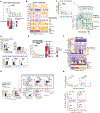A cytotoxic-skewed immune set point predicts low neutralizing antibody levels after Zika virus infection
- PMID: 35584677
- PMCID: PMC9151348
- DOI: 10.1016/j.celrep.2022.110815
A cytotoxic-skewed immune set point predicts low neutralizing antibody levels after Zika virus infection
Abstract
Although generating high neutralizing antibody levels is a key component of protective immunity after acute viral infection or vaccination, little is known about why some individuals generate high versus low neutralizing antibody titers. Here, we leverage the high-dimensional single-cell profiling capacity of mass cytometry to characterize the longitudinal cellular immune response to Zika virus (ZIKV) infection in viremic blood donors in Puerto Rico. During acute ZIKV infection, we identify widely coordinated responses across innate and adaptive immune cell lineages. High frequencies of multiple activated cell types during acute infection are associated with high titers of ZIKV neutralizing antibodies 6 months post-infection, while stable immune features suggesting a cytotoxic-skewed immune set point are associated with low titers. Our study offers insight into the coordination of immune responses and identifies candidate cellular biomarkers that may offer predictive value in vaccine efficacy trials aimed at inducing high levels of antiviral neutralizing antibodies.
Keywords: CP: Immunology; CyTOF; Zika virus; immune signatures; neutralizing antibodies; systems immunology.
Copyright © 2022 The Author(s). Published by Elsevier Inc. All rights reserved.
Conflict of interest statement
Declaration of interests M.H.S. is founder and a board member of Teiko Bio, has received consultant fees from Five Prime Therapeutics, Earli, Ono Pharmaceutical, and January, and has received research funding from Roche/Genentech, Pfizer, Valitor, and Bristol-Myers Squibb.
Figures





Similar articles
-
Recombinant Chimpanzee Adenovirus Vaccine AdC7-M/E Protects against Zika Virus Infection and Testis Damage.J Virol. 2018 Feb 26;92(6):e01722-17. doi: 10.1128/JVI.01722-17. Print 2018 Mar 15. J Virol. 2018. PMID: 29298885 Free PMC article.
-
Development of Virus-Like-Particle Vaccine and Reporter Assay for Zika Virus.J Virol. 2017 Sep 27;91(20):e00834-17. doi: 10.1128/JVI.00834-17. Print 2017 Oct 15. J Virol. 2017. PMID: 28794019 Free PMC article.
-
Cellular and Humoral Immunity Protect against Vaginal Zika Virus Infection in Mice.J Virol. 2018 Mar 14;92(7):e00038-18. doi: 10.1128/JVI.00038-18. Print 2018 Apr 1. J Virol. 2018. PMID: 29343577 Free PMC article.
-
Immune Responses to Dengue and Zika Viruses-Guidance for T Cell Vaccine Development.Int J Environ Res Public Health. 2018 Feb 23;15(2):385. doi: 10.3390/ijerph15020385. Int J Environ Res Public Health. 2018. PMID: 29473899 Free PMC article. Review.
-
Recent advances in understanding the adaptive immune response to Zika virus and the effect of previous flavivirus exposure.Virus Res. 2018 Aug 2;254:27-33. doi: 10.1016/j.virusres.2017.06.019. Epub 2017 Jun 26. Virus Res. 2018. PMID: 28655548 Free PMC article. Review.
Cited by
-
Comprehensive analysis of early T cell responses to acute Zika Virus infection during the first epidemic in Bahia, Brazil.PLoS One. 2024 May 9;19(5):e0302684. doi: 10.1371/journal.pone.0302684. eCollection 2024. PLoS One. 2024. PMID: 38722858 Free PMC article.
-
Zika virus: an overview update.Curr Opin HIV AIDS. 2025 May 1;20(3):294-302. doi: 10.1097/COH.0000000000000926. Epub 2025 Mar 17. Curr Opin HIV AIDS. 2025. PMID: 40048580 Free PMC article. Review.
-
Combination immunotherapy induces post-intervention control of HIV.Res Sq [Preprint]. 2025 Mar 19:rs.3.rs-6141479. doi: 10.21203/rs.3.rs-6141479/v1. Res Sq. 2025. PMID: 40166020 Free PMC article. Preprint.
References
-
- Abbink P, Larocca RA, De La Barrera RA, Bricault CA, Moseley ET, Boyd M, Kirilova M, Li Z, Ng’ang’a D, Nanayakkara O, et al. (2016). Protective efficacy of multiple vaccine platforms against Zika virus challenge in rhesus monkeys. Science 353, 1129–1132. 10.1126/science.aah6157. - DOI - PMC - PubMed
-
- Abbink P, Larocca RA, Visitsunthorn K, Boyd M, De La Barrera RA, Gromowski GD, Kirilova M, Peterson R, Li Z, Nanayakkara O, et al. (2017). Durability and correlates of vaccine protection against Zika virus in rhesus monkeys. Sci. Transl. Med 9, eaao4163. 10.1126/sci-translmed.aao4163. - DOI - PMC - PubMed
-
- Andrade P, Gimblet-Ochieng C, Modirian F, Collins M, Cárdenas M, Katzelnick LC, Montoya M, Michlmayr D, Kuan G, Balmaseda A, et al. (2019). Impact of pre-existing dengue immunity on human antibody and memory B cell responses to Zika. Nat. Commun 10, 938. 10.1038/s41467-019-08845-3. - DOI - PMC - PubMed
-
- Andrews SF, Chambers MJ, Schramm CA, Plyler J, Raab JE, Kanekiyo M, Gillespie RA, Ransier A, Darko S, Hu J, et al. (2019). Activation dynamics and Immunoglobulin evolution of pre-existing and newly generated human memory B cell responses to influenza hemagglutinin. Immunity 51, 398–410.e5. 10.1016/j.immuni.2019.06.024. - DOI - PubMed
Publication types
MeSH terms
Substances
Grants and funding
LinkOut - more resources
Full Text Sources
Medical
Miscellaneous

